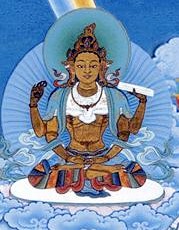Prajnaparamita: Difference between revisions
Jump to navigation
Jump to search
No edit summary |
No edit summary |
||
| Line 1: | Line 1: | ||
[[Image:Prajnaparamita.jpg|frame|'''Prajñaparamita''']] | [[Image:Prajnaparamita.jpg|frame|'''Prajñaparamita''']] | ||
'''Prajñaparamita''' [Skt.] (Tib. ''sherchin''; [[wyl.]] ''sher phyin'') – literally, ‘transcendent wisdom’. 1. the sixth of the [[paramitas]]: perfect non-conceptual wisdom. 2. the class of Buddhist literature that was mainly discovered by [[Nagarjuna]] in the second century. Its central topic is emptiness. | '''Prajñaparamita''' [Skt.] (Tib. ''sherchin''; [[wyl.]] ''sher phyin'') – literally, ‘transcendent wisdom’. 1.) the sixth of the [[paramitas]]: perfect non-conceptual wisdom. 2.) the class of Buddhist literature that was mainly discovered by [[Nagarjuna]] in the second century. Its central topic is emptiness. 3.) the female deity who is the embodiment of transcendent wisdom. | ||
===Scholarly Definition=== | ===Scholarly Definition=== | ||
| Line 19: | Line 19: | ||
[[Category:Key Terms]] | [[Category:Key Terms]] | ||
[[Category:Buddhas and Deities]] | |||
Revision as of 14:05, 23 May 2007

Prajñaparamita [Skt.] (Tib. sherchin; wyl. sher phyin) – literally, ‘transcendent wisdom’. 1.) the sixth of the paramitas: perfect non-conceptual wisdom. 2.) the class of Buddhist literature that was mainly discovered by Nagarjuna in the second century. Its central topic is emptiness. 3.) the female deity who is the embodiment of transcendent wisdom.
Scholarly Definition
"Prajnaparamita is the wisdom of directly realizing the non-conceptual simplicity of all phenomena, which has arrived at, or will lead one to, non-abiding nirvana."
- --From The Words of Jikme Chökyi Wangpo by Khenpo Tsöndrü.
Subdivisions
There are said to be four subdivisions:
- natural prajnaparamita
- scriptural prajnaparamita
- path prajnaparamita
- resultant prajnaparamita